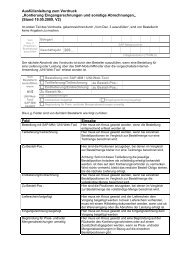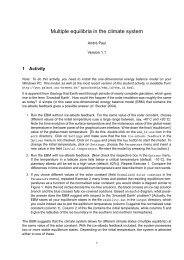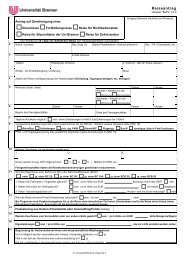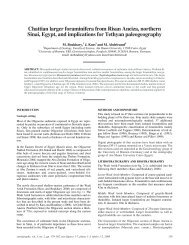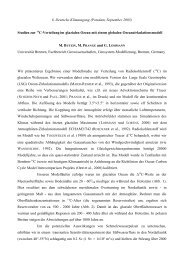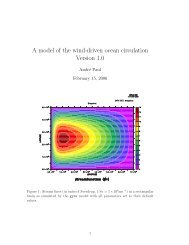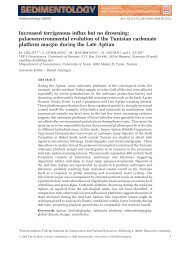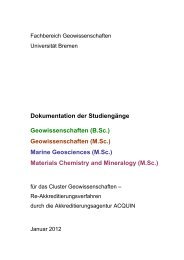Forschung im HLRN-Verbund 2011
Forschung im HLRN-Verbund 2011
Forschung im HLRN-Verbund 2011
- Keine Tags gefunden...
Sie wollen auch ein ePaper? Erhöhen Sie die Reichweite Ihrer Titel.
YUMPU macht aus Druck-PDFs automatisch weboptimierte ePaper, die Google liebt.
26Transport across biological membranesMolecular dynamics s<strong>im</strong>ulations of motor and proton transporter proteinsA.-N. Bondar, Free University Berlin, Departmentof PhysicsAbstract• Dynamics and conformational coupling are necessaryfor the functioning of motor and transporterproteins. Changes in hydrogen-bondinginteractions between protein amino acids canbe directly involved in large-scale conformationalchanges of the protein.• The cytosolic SecA motor is an essential componentof the Sec translocation system in bacteria.SecA couples the hydrolysis of adenosinetriphosphate (ATP) with remarkable conformationalchanges of the SecA-SecYEG translocasethat lead to the translocation of secretoryproteins across the membrane. To begin to understandthe molecular mechanism that ensureslong-distance coupling in SecA, we will performprolonged Molecular Dynamics (MD) s<strong>im</strong>ulationsof SecA in a box of water molecules.• Channelrhodopsin-2 (ChR-2) is a light-gatedcation channel with applications in neurobiology.The crystal structure of ChR-2 has not beensolved yet. To gain insight into the functionalrole of putatively <strong>im</strong>portant hydrogen-bonding interactions,we will investigate the dynamics ofhomology models of ChR-2, and mutants of thebacteriorhodopsin proton pump.Proteins are synthesized in the cytoplasm, a fluidmatrix that fills the space between the compartmentsof the cell. To ensure their proper structureand functional state, newly synthesized proteinsoften require transport to specific subcellularcompartments. These tasks are performed by sophisticatedmachineries present in all branches oflife. The Sec system, whose essential componentsare the cytosolic SecA motor and the membraneembeddedSecYEG channel, is a major route forprotein secretion in bacteria; toxins are amongthe proteins secreted via the SecA path. Understandinghow SecA works is a critical point forunderstanding protein biosynthesis, and can have<strong>im</strong>portant applications for developing ant<strong>im</strong>icrobialagents.SecA is a large protein that contains several domains(Figure 1). Crystal structures indicate thatthe changes in the structure of SecA during proteintranslocation are indeed remarkable. The ProteinBinding Domain (PBD) is the structural elementthat exhibits the largest conformational variabilityamong the SecA crystal structures: it hadbeen suggested that opening of SecA involves alarge rigid-body rotation of the PBD [1]. The conformationof the PBD could, however, be affectedby the crystallization conditions, and the s<strong>im</strong>ilaritybetween the overall structures of the NucleotideBinding Domains (NBDs) in different nucleotidebindingstates could <strong>im</strong>ply that <strong>im</strong>portant conformationssampled by SecA are not represented by thecrystal structures [2]. As a key step towards understandinghow SecA works, we will perform prolongedall-atom MD s<strong>im</strong>ulations to characterize thestructure and dynamics of the SecA motor in theopen and closed states. This work will provide thefoundation for future investigations of the mechanismif chemo-mechanical coupling in SecA.Computer s<strong>im</strong>ulations are a well-established,cost-effective method that allows us to probe thegeometry and the motions of proteins. The s<strong>im</strong>ulationsrequire the coordinates of each atom of theprotein, which are known from X-ray crystallography,and use a set of equations describing the interactionsof each protein atom with other proteinatoms and with the environment. The s<strong>im</strong>ulationconsists of solving numerically the classical t<strong>im</strong>edependentequations that describe the motion ofthe collection of atoms making up the protein andits environment (such as water and molecules).Prolonged s<strong>im</strong>ulations of 50–100 nanosecondsare required to equilibrate thoroughly large systems(approx. 200.000 atoms) consisting of proteinsand solvent molecules. High-performanceparallel computing made possible by the <strong>HLRN</strong> willallow us to sample efficiently the long-t<strong>im</strong>escale dynamicsof SecA in a large box of water molecules.The microbial-type ChR-2 is a light-gatedcation channel that consists of a transmembranerhodopsin domain, and a cytosolic C-terminal domain.Absorption of light by the retinal chromophoretriggers a reaction cycle in which conformationalchanges of the protein are associatedwith opening and closing of the channel. Severalamino acids critical for the ion pumping or sensoryactivity of other members of the microbialtyperhodopsins are replaced in ChR-2, where theyare likely <strong>im</strong>plicated in function. For example, <strong>im</strong>portantdifferences are observed between the sequencesof amino acids of ChR-2 and the protonpumpingbacteriorhodopsin in regions that in bacteriorhodopsinare directly involved in proton uptakeand release.Investigating the specific roles of these aminoacids offers a unique opportunity to understand theChemie



